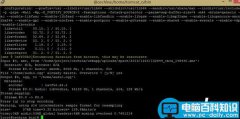在linux awk的 while、do-while和for语句中允许使用break,continue语句来控制流程走向,也允许使用exit这样的语句来退出。break中断当前正在执行的循环并跳到循环外执行下一条语句。if 是流程选择用法。 awk中,流程控制语句,语法结构,与c语言类型。下面是各个语句用法。
一.条件判断语句(if)
if(表达式) #if ( Variable in Array )
语句1
else
语句2
格式中"语句1"可以是多个语句,如果你为了方便Unix awk判断也方便你自已阅读,你最好将多个语句用{}括起来。Unix awk分枝结构允许嵌套,其格式为:
if(表达式)</p> <p>{语句1}</p> <p>else if(表达式)
{语句2}
else
{语句3}
[chengmo@localhost nginx]# awk 'BEGIN{
test=100;
if(test>90)
{
print "very good";
}
else if(test>60)
{
print "good";
}
else
{
print "no pass";
}
}'
very good
每条命令语句后面可以用“;”号结尾。
二.循环语句(while,for,do)
1.while语句
格式:
while(表达式)
{语句}
例子:
[chengmo@localhost nginx]# awk 'BEGIN{
test=100;
total=0;
while(i<=test)
{
total+=i;
i++;
}
print total;
}'
5050
2.for 循环
for循环有两种格式:
格式1:
for(变量 in 数组)
{语句}
例子:
[chengmo@localhost nginx]# awk 'BEGIN{
for(k in ENVIRON)
{
print k"="ENVIRON[k];
}
}' </p> <p>AWKPATH=.:/usr/share/awk
OLDPWD=/home/web97
SSH_ASKPASS=/usr/libexec/openssh/gnome-ssh-askpass
SELINUX_LEVEL_REQUESTED=
SELINUX_ROLE_REQUESTED=
LANG=zh_CN.GB2312
。。。。。。
说明:ENVIRON 是awk常量,是子典型数组。
格式2:
for(变量;条件;表达式)
{语句}
例子:
[chengmo@localhost nginx]# awk 'BEGIN{
total=0;
for(i=0;i<=100;i++)
{
total+=i;
}
print total;
}'
5050
3.do循环
格式:
do
{语句}while(条件)
例子:
[chengmo@localhost nginx]# awk 'BEGIN{
total=0;
i=0;
do
{
total+=i;
i++;
}while(i<=100)
print total;
}'
5050
以上为awk流程控制语句,从语法上面大家可以看到,与c语言是一样的。有了这些语句,其实很多shell程序都可以交给awk,而且性能是非常快的。
| break | 当 break 语句用于 while 或 for 语句时,导致退出程序循环。 |
| continue | 当 continue 语句用于 while 或 for 语句时,使程序循环移动到下一个迭代。 |
| next | 能能够导致读入下一个输入行,并返回到脚本的顶部。这可以避免对当前输入行执行其他的操作过程。 |
| exit | 语句使主输入循环退出并将控制转移到END,如果END存在的话。如果没有定义END规则,或在END中应用exit语句,则终止脚本的执行。 |
三、性能比较
[chengmo@localhost nginx]# time (awk 'BEGIN{ total=0;for(i=0;i<=10000;i++){total+=i;}print total;}')
50005000
real 0m0.003s
user 0m0.003s
sys 0m0.000s
[chengmo@localhost nginx]# time(total=0;for i in $(seq 10000);do total=$(($total+i));done;echo $total;)
50005000
real 0m0.141s
user 0m0.125s
sys 0m0.008s
实现相同功能,可以看到awk实现的性能是shell的50倍!




![RedHat服务器上[Errno 5] OSError: [Errno 2]的解决方法](https://img.pc-daily.com/uploads/allimg/4752/11135115c-0-lp.png)

